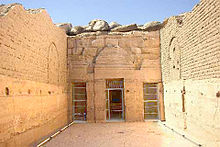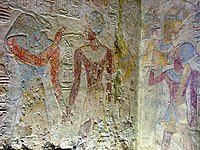
Thebes, known to the ancient Egyptians as Waset, was an ancient Egyptian city located along the Nile about 800 kilometers (500 mi) south of the Mediterranean. Its ruins lie within the modern Egyptian city of Luxor. Thebes was the main city of the fourth Upper Egyptian nome and was the capital of Egypt for long periods during the Middle Kingdom and New Kingdom eras. It was close to Nubia and the Eastern Desert, with its valuable mineral resources and trade routes. It was a cult center and the most venerated city during many periods of ancient Egyptian history. The site of Thebes includes areas on both the eastern bank of the Nile, where the temples of Karnak and Luxor stand and where the city was situated; and the western bank, where a necropolis of large private and royal cemeteries and funerary complexes can be found. In 1979, the ruins of ancient Thebes were classified by UNESCO as a World Heritage Site.

Khnum or also romanised Khnemu was one of the earliest-known Egyptian deities, originally the god of the source of the Nile. Since the annual flooding of the Nile brought with it silt and clay, and its water brought life to its surroundings, he was thought to be the creator of the bodies of human children, which he made at a potter's wheel, from clay, and placed in their mothers' wombs. He was later described as having moulded the other deities, and he had the titles "Divine Potter" and "Lord of created things from himself".

Satet,Satit or Satjet, Satjit in Ancient Egyptian, Greek: Satis, also known by numerous related names, was an Upper Egyptian goddess who, along with Khnum and Anuket, formed part of the Elephantine Triad. A protective deity of Egypt's southern border with Nubia, she came to personify the former annual flooding of the Nile and to serve as a war, hunting, and fertility goddess.

Nefertari, also known as Nefertari Meritmut, was an Egyptian queen and the first of the Great Royal Wives of Ramesses the Great. She is one of the best known Egyptian queens, among such women as Cleopatra, Nefertiti, and Hatshepsut, and one of the most prominent not known or thought to have reigned in her own right. She was highly educated and able to both read and write hieroglyphs, a very rare skill at the time. She used these skills in her diplomatic work, corresponding with other prominent royals of the time. Her lavishly decorated tomb, QV66, is one of the largest and most spectacular in the Valley of the Queens. Ramesses also constructed a temple for her at Abu Simbel next to his colossal monument there.
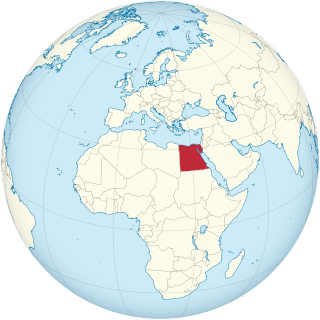
Articles related to Egypt include:

Abu Simbel is a historic site comprising two massive rock-cut temples in the village of Abu Simbel, Aswan Governorate, Upper Egypt, near the border with Sudan. It is situated on the western bank of Lake Nasser, about 230 km (140 mi) southwest of Aswan. The complex is part of the UNESCO World Heritage Site known as the "Nubian Monuments", which run from Abu Simbel downriver to Philae, and include Amada, Wadi es-Sebua, and other Nubian sites. The twin temples were originally carved out of the mountainside in the 13th century BC, during the 19th Dynasty reign of the Pharaoh Ramesses II. They serve as a lasting monument to the king Ramesses II. His wife Nefertari and children can be seen in smaller figures by his feet, considered to be of lesser importance and were not given the same position of scale. This commemorates his victory at the Battle of Kadesh. Their huge external rock relief figures have become iconic.

Elephantine is an island on the Nile, forming part of the city of Aswan in Upper Egypt. The archaeological sites on the island were inscribed on the UNESCO World Heritage List in 1979 along with other examples of Upper Egyptian architecture, including Abu Simbel and Philae.
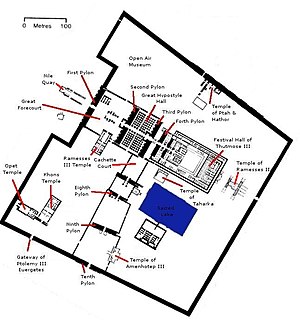
The Precinct of Amun-Re, located near Luxor, Egypt, is one of the four main temple enclosures that make up the immense Karnak Temple Complex. The precinct is by far the largest of these and the only one that is open to the general public. The temple complex is dedicated to the principal god of the Theban Triad, Amun, in the form of Amun-Re.

Gebel el-Silsila or Gebel Silsileh is 65 km (40 mi) north of Aswan in Upper Egypt, where the cliffs on both sides close to the narrowest point along the length of the entire Nile. The location is between Edfu in the north towards Lower Egypt and Kom Ombo in the south towards Upper Egypt. The name Kheny means "The Place of Rowing". It was used as a major quarry site on both sides of the Nile from at least the 18th Dynasty to Greco-Roman times. Silsila is famous for its New Kingdom stelai and cenotaphs.
New Kalabsha is a promontory located near Aswan in Egypt. It houses several important temples, structures, and other remains that have been relocated here from the site of Old Kalabsha and other sites in Lower Nubia, to avoid the rising waters of Lake Nasser caused by the construction of the Aswan High Dam. The major remains are described below:

Amun-her-khepeshef was the firstborn son of Pharaoh Ramesses II and Queen Nefertari.

The National Museum of Sudan or Sudan National Museum, abbreviated SNM, is a two-story building constructed in 1955 and established as a museum in 1971. The building and its surrounding gardens house the largest and most comprehensive Nubian archaeological collection in the world including objects from the Paleolithic through to the Islamic period originating from every site of importance in the Sudan.

Wadi es-Sebua, or Valley of the Lions, is the site of two New Kingdom Egyptian temples, including one speos temple constructed by the 19th Dynasty Pharaoh Ramesses II, in Lower Nubia.
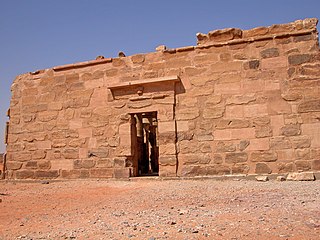
Temple of Al-Maharraqa is an ancient Egyptian Temple dedicated to Isis and Serapis. It is located in al-Maharraqa, Lower Nubia, approximately 140 km (87 mi) south of Aswan on the southern border of the Roman empire.

The Temple of Derr or el-Derr is a speos or rock-cut Egyptian temple in Lower Nubia. It was built during the 19th Dynasty by Pharaoh Ramesses II. It is the only rock-cut temple in Nubia, which was constructed by this pharaoh on the right bank of the Nile and used to stand at el-Derr. The temple's unique position "was probably because the river on its approach to the Korosko bend flows in an 'unnatural' southeasterly direction." The Derr structure was known in ancient times as 'The Temple of Ri'amsese-meryamun [Ramesses II] in the Domain of Re ' and was dedicated to the god Ra-Horakhty. Scholars disagree over its precise construction date: the French Egyptologist Nicolas Grimal states that it was built in the thirtieth year of Ramesses II, presumably to coincide with his first royal jubilee. John Baines and Jaromír Málek also write that the temple of Derr "was built in the second half of the king's reign", likely because its "plan and decoration resembles the Great Temple of Abu Simbel ." Abu Simbel was built between Year 24 and Year 31 of Ramesses' reign. According to Joyce Tyldesley, the Temple of Derr was built by Setau, who is known to have served as Ramesses' Viceroy of Kush or Nubia between Year 38 to 63 of this pharaoh's reign.

Setau was the Viceroy of Kush in the second half of Ramesses II's reign. Contemporary records show that Setau served in this position from Year 38 until at least Year 63 of Ramesses II's reign. Setau was "a graduate of the royal school" and already enjoyed an impressive record of royal service which is detailed in a long autobiographical inscription carved at Wadi es-Sebua. The temple of Wadi es-Sebua was built for Ramesses II by Setau around 1236 BC or Year 44 of this pharaoh's reign. Eleven of his stela, now in the Cairo Museum, were found in the courtyard of this temple and make it possible to establish his career and understand the precise duties of a viceroy. Setau states:
I was one whom his Lord caused to instructed....as a ward of the palace. I grew up in the royal abode when I was a youth...I was provided for with bread and beer from all the royal meals. I came forth as a scribe from the school, I was appointed to be Chief Scribe of the Vizier; I assessed the whole land with a scroll. A task I being equal to the task.

The Temple of Amada, the oldest Egyptian temple in Nubia, was first constructed by Pharaoh Thutmose III of the 18th dynasty and dedicated to Amun and Re-Horakhty. His son and successor, Amenhotep II continued the decoration program for this structure. Amenhotep II's successor, Thutmose IV decided to place a roof over its forecourt and transform it into a pillared or hypostyle hall. During the Amarna period, Akhenaten had the name Amun destroyed throughout the temple but this was later restored by Seti I of Egypt's 19th Dynasty. Various 19th Dynasty kings especially Seti I and Ramesses II also "carried out minor restorations and added to the temple's decoration." The stelas of the Viceroys of Kush Setau, Heqanakht and Messuy and that of Chancellor Bay describe their building activities under Ramesses II, Merneptah and Siptah respectively. In the medieval period the temple was converted into a church.
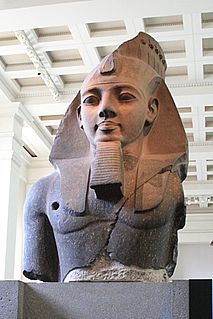
Ramesses II, commonly known as Ramesses the Great, was the third pharaoh of the Nineteenth Dynasty of Egypt. Along with Thutmose III he is often regarded as the greatest, most celebrated, and most powerful pharaoh of the New Kingdom, itself the most powerful period of Ancient Egypt.

The Eighteenth Dynasty of Egypt is classified as the first dynasty of the New Kingdom of Egypt, the era in which ancient Egypt achieved the peak of its power. The Eighteenth Dynasty spanned the period from 1550/1549 to 1292 BC. This dynasty is also known as the Thutmosid Dynasty for the four pharaohs named Thutmose.
This page list topics related to ancient Egypt.
